
Are you constantly trying to generate new leads?
You’re not alone. And that’s the problem.
Let me guess, you’re always pushing out free ebook downloads and email-gated case studies?
Thought so. Lead generation today can get pretty repetitive.
Sometimes it can feel impossible to make your offer stand out amidst thousands of others.
If only there were a more unique and exciting offer you could use to get new leads for your business.
Luckily for you, there is.
Find out how you can convince potential customers to opt in by telling them how much they suck.
No, seriously. I’ll explain.
Strategy Briefing
64% of B2B marketers used ebooks as a lead generation strategy in 2013.
75% rated case studies as the main form of gated content.
Everyone uses them because, let’s face it, they work. But potential leads are looking for something new to grab their attention.
Capture them with a personalized scorecard.
A personalized scorecard is all about your company providing leads with feedback on something they have created such as a landing page, email newsletter or even how they’ve arranged their bedroom.
It’s offering a free evaluation of their efforts. Customers get valuable expert advice and you get a new email lead.
Follow along and learn…
- How to choose what to review
- Examples of scorecard reviews
- How to create your own scorecard
- How to follow up and nurture new leads with email (based on their score)
Figure Out What Your Target Audience Needs
For your review scorecard to attract new leads it needs to be an offer that your target audience can’t resist. You need to give them advice on the main issue they’re struggling with.
The question is… what is their main concern?
The first step in any marketing plan is to identify and play to your target audience. If you don’t know who you’re trying to reach, persuade, and get a lead from, you’re not going to be able to entice them with your offer.
As a marketing company, our target audience is small to medium-sized businesses who need help generating and nurturing leads. We know exactly who our target client is, and tailor our products and services to their needs.
So how can we find out exactly what they want? The best way to discover their needs is, unsurprisingly, to ask.
Send out an email to your merchants or hold a poll on your website to find out the issues they’re facing. If there’s one issue causing your existing clients problems, it’s likely hurting potential clients as well.
No one knows better what your target audience wants than those who have bought from you in the past!
Email Out a Questionnaire
Send out an email to your clients and existing leads asking them to complete a short questionnaire.
The questionnaire may ask them what issues they’re currently facing or what concerns they have. Wishpond, as an online marketing company, may ask what aspect of marketing they are struggling with most.
Our email may look something like this:
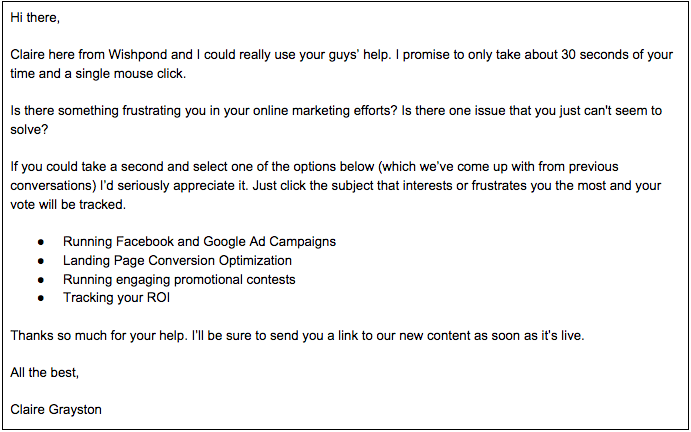
This simple type of email questionnaire takes little very time out of your day and theirs, but gives you the answers you need.
In order to create a poll in an email on the Mailchimp platform simply put your topics within the survey merge tags, which look like *|SURVEY: [your subject idea]|*.
Here’s what it looks like within the Mailchimp campaign builder:
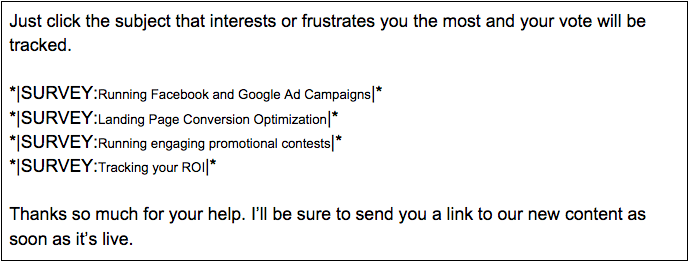
Another great strategy to ensure you’re creating a lead gen offer your target market wants is to post a simple poll on your website or blog. Check out https://wordpress.org/plugins/search.php?q=poll for a bunch of great WordPress poll plugins. If you use Blogger, here’s a simple how-to guide.
Placing a poll on your site and sending an email blast gets you the information you need before you create your scorecard review, and also generates serious buzz around it.
3 Scorecard Review Examples
You can do a review scorecard for any type of business. Here are 3 examples of scorecards for B2B and B2C businesses:
B2B Example 1: Facebook Ad Manager Scorecard
As of 2014, over 30 million small businesses use Facebook as a marketing tool. For many of them that also means Facebook Ads. One scorecard review idea for a B2B business (like Wishpond) would be to have clients send in a screenshot of their Facebook Ad Campaign Manager.
By providing them with valuable feedback they can learn how to gain more bang from their Facebook buck. A great example of this type of review can be seen below with a Wishpond Ad being analyzed. The expert gives the client 6 different ways they can optimize their campaign to see better results.
Anyone struggling to generate return from their Facebook Ads would be more than willing to give up their email address for specific, tailored information that benefits their business.
Create a blog banner with a matching click popup to generate leads through a Facebook Ad review scorecard. On your popup you can ask leads for information about their business and get them to upload a screenshot of their Ad Manager. This allows you to see what parts of their Ad they could better utilize to get more return.
Here is an example of an Ad Manager review scorecard we have done for a mock Wishpond Ad. It includes the screenshot of the Ad Manager with our analysis of the different parts below.
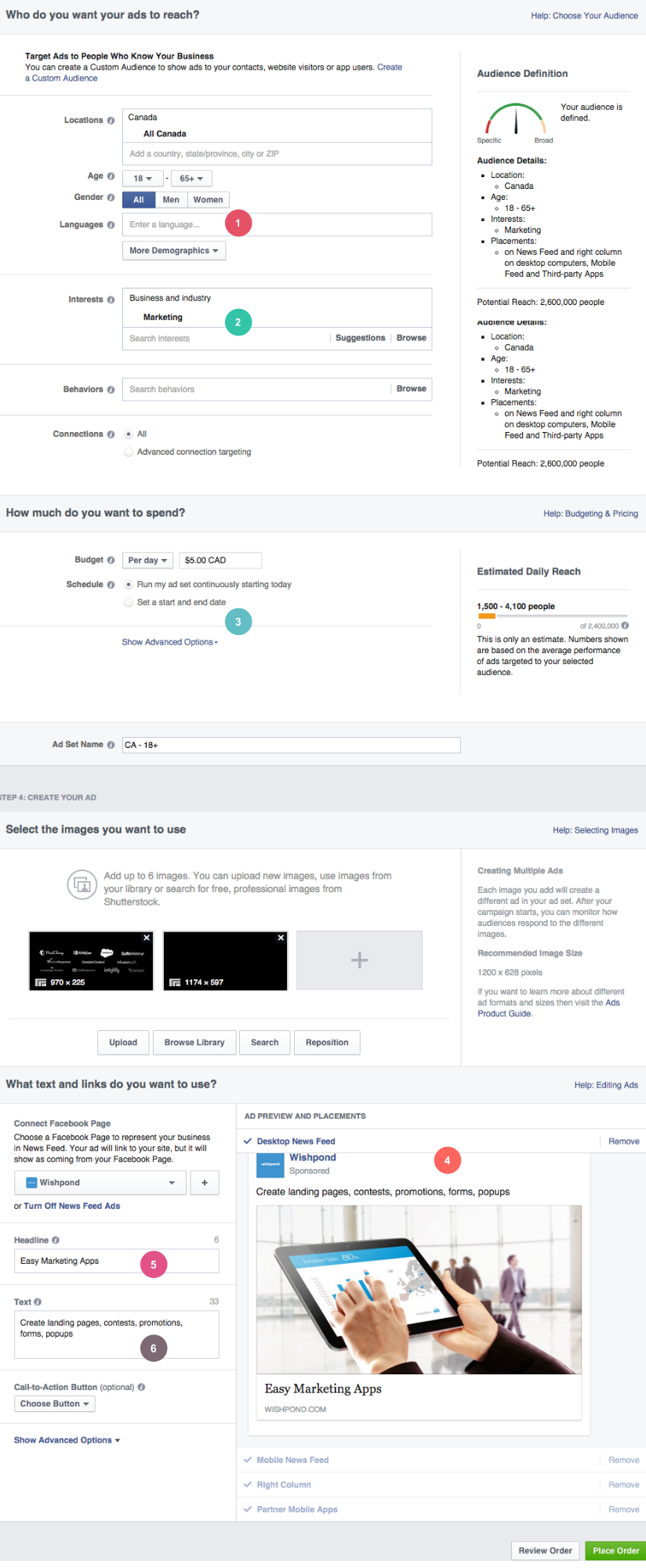
Score: C
Here’s how you can easily improve your Facebook Ad:
1 – When promoting software designed for the English-speaking market, be sure you’re not spending money reaching people who don’t speak the language. Small details like this can make a big difference in your Ad reach.
2 – “Marketing” is a very broad demographic. Consider removing it and adding, instead, people interested in specific sections of your tools (like lead generation, customer relationship management, online advertising, etc).
3 – To drive traffic to your site, choose “optimize for clicks” under the advanced options dropdown. Bid at the upper end of Facebook’s suggested bid range in order to reach the maximum number of users within your target audience.
4 – Your image doesn’t stand out from the Facebook platform (light blue and white). Go with an image of a smiling person in red, orange or green to grab the attention of Facebook users. Don’t forget that you are competing with a user’s own family and friends for their Facebook attention.
5 – Your headline needs to be attention-grabbing. Consider a question related to your tools like “need [the outcome of your software]? or percentage points like “200% ROI Guaranteed.” Easy Marketing Apps does not trigger curiosity in Facebook users.
6 – Your ad’s body copy needs to inform and excite. Consider urgency phrases like “limited time” and “This month only” with a discounted offer on your products or services.
B2B Example 2: Landing Page Scorecard
For a landing page review scorecard, again ask leads to email or upload a screenshot of their current landing page. Use a form or a popup to get their email address and screenshot in order to complete your evaluation.
Here is our evaluation of what we like and don’t like about this business’ landing page:
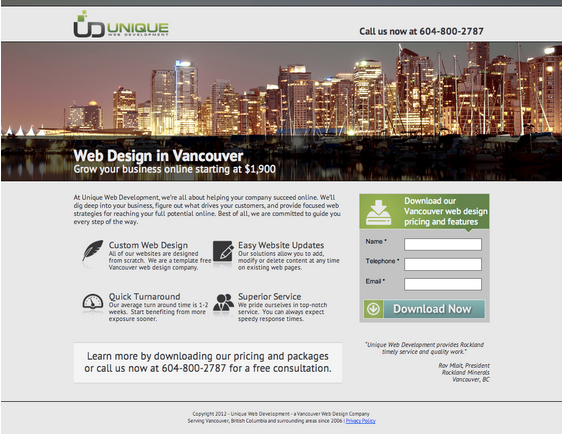
Score: B
What we like:
The benefit list: We love how you have focused on the benefits to the consumer of using your service rather than just listing the features. This tactic hones in on the true value for the client, telling them exactly why they should use your business.
The customer testimonial: It’s succinct and compliments their benefits. Plus, it also details the exact person they quoted with a name, company, and location adding credibility and believability.
The encapsulated form: This form stands out but doesn’t overwhelm the page like many forms do. It only has 3 form fields making it easy and quick to convert. It’s clear that the purpose of the page is to get the visitor to download their pricing and features.
The length of the page: This landing page works because it doesn’t drag on with distracting links and too much text. Instead, it gets straight to the point – a great tactic for landing page optimization.
The price: You’ve nailed the fact that people looking for web designers are likely comparing your business with others. Price points can definitely be a deciding factor, so we like how you have listed a starting price that is easy to spot.
What we would change or test:
The visual: As much as the photo of Vancouver is captivating, it’s not about to encourage a lead to download your form unless they have a soft spot for Vancouver. I would test using a photo that would be more universally recognized, or even featuring an image of an existing client with a short testimonial.
Make the customer testimonial more obvious: It’s hiding in italic font below the focal pricing and features form, which means your client’s attention won’t be on the customer testimonial. Place it in a more obvious space, making it larger and changing the font color to something that contrasts more with the gray background. A picture also adds to the credibility of your testimonial, assuring potential clients that it is a true, honest review.
This type of rating gives Unique Web Development an in-depth and specific evaluation. They get expert advice about how they can increase their conversions from their landing page.
In this example the expert gives positive reinforcement as well confirming what the client is doing well.
B2C Example 1: Personalized Interior Design Scorecard
As a B2C business it may seem hard to give direct feedback to potential customers without speaking to them face to face. While in B2B they can send you content and ask for advice, the same wouldn’t work for a clothing store (for instance).
However, it might be easier than you think.
If you’re an interior design company, you likely have a blog as well as a company website. One way you can engage with potential leads and make them convert would be to ask them to email in or upload pictures of a room in their house, requesting a free scorecard review. You can also invest in an interior design project management software that can ease your team workflow from design all the way down to marketing.
A scorecard review would allow the business to showcase their design expertise, tailoring the recommendations to their products with links back to their online catalog. An example can be seen below from a customer sending in photos of their arrangement-troubled living room:


Score: B
Thanks for sending in your photos. You’re definitely on the right path, there are certain elements of this room that we love. In terms of furniture we think you’ve got the right color accents and pieces for this room type, shape, and purpose. Here is what we would change:
1. The arrangement – It’s hard to properly arrange furniture when you have a TV wall separate from your fireplace mantle wall. Our recommendation would be to swap the location of the sofa and the arm chair. Having the sofa parallel to the wall opens the room up creating a real flow. This would allow you and your guests to better utilize the whole space and the beautiful fireplace.
2. Window treatments – It’s great that you have a room with so much natural light, but having real blinds on the window would really help improve this space. Fabric or roman shades are a great alternative to your nearly nonexistent blinds. They will prevent glare on the tv and give your family some privacy at night.
3. The packed media centre – We are huge fans of your storage media centre, but leaving it all open can make the entire space seem cluttered. It’s easy to install fabric panels or sliding doors to hide your games, blankets, and books. This keeps the room clean and elegant while still entertaining friendly.
4. An area rug – One last tweak to spice up this space would be the addition of an area rug. The room could use a bit of a color boost, and an area rug could be the perfect solution. We would suggest a fun pattern such as our Color Frenzy design seen here.
We hope you found these tips helpful. If you have any questions feel free to email [email protected] or visit our website extendfurtniture.com
This shows how a B2C company can engage potential customers with honest, valuable advice. I know most people would love these kinds of tips for free for their own home, in return giving the business valuable leads for the future.
3. How to Create Your Scorecard
Now that you’ve seen how easily it can be done, it’s time to start thinking of what to include on your scorecard when ranking your lead’s landing page, advertisement, living room, etc.
For this example I am going to use the Facebook Ad example to showcase how to make your scorecard review.
Create a scale (for this example we’ll go with 1-5) of different options you may select when ranking the content. Your scorecard needs to have questions that are easy to answer in yes or no format. There can be no grey area. You want it to be easy to fill out for every piece of your clients’ content that you receive.
Before you start on your scorecard, you need to know the objectives and budget of your leads. This is done through capturing specific lead information during the generation stage. I’ll show you how to do this with a click popup in Section 3.
For the Facebook Ads review above, I have created this scorecard:

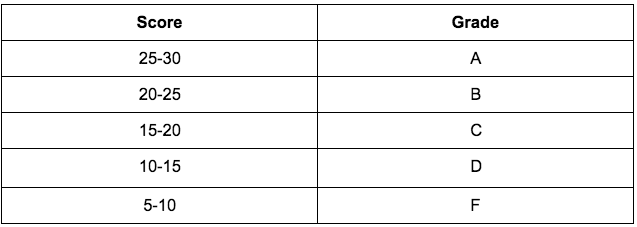
Create a Blog CTA Banner to Showcase Your New Lead-Gen Strategy
Now that you have this awesome new lead generation strategy, you need to make sure it’s seen. A great way to do this is to add a click popup to your blog to capture readers and turn them into leads.
This is an especially effective way to generate interested leads as you can post your “analysis of a landing page” on articles relevant to landing page optimization.
Click popups are less intrusive than other types of popups, as visitors take the action and click a call-to-action banner to access the content. You know that they’ve opted-in to your popup form to get your content – instead of just entering an email to make it go away.
For the Facebook Ad example, we would use this banner on our blog’s footer:

1. It has an intriguing headline that focuses on the target audience’s pain point
2. It makes it clear what the lead will gain by clicking on the call-to-action button
3. It gives potential leads a timeline for a response. This gives them certainty that they will benefit and get actual results soon.
Once visitors click on the banner, they would arrive at this click popup:

1. It is consistent with the blog banner in both color and copy, using the headline to inform them exactly what they’re signing up for.
2. It asks for multiple form fields to get information about the lead’s business, without overwhelming them with too many asks.
We need to know their goals and see an image of their Ad Manager to know the current state of their Ad campaign.
Learn how to add a click popup with Wishpond here!
How to Follow Up With New Scorecard Leads
You’ve captured your lead! Unfortunately that isn’t where the hard work ends. Now that you have that reader’s email and their personal information, you need to target them with relevant content to nurture them into a sale.
Leads are awesome, but realistically you want paying customers.
Research estimates that 40-50% of all inbound sales leads are never followed up with.
Let’s see if we can do better.
Target New Leads with an Email Drip Campaign
A drip campaign is a set of email messages sent out to leads over time, personalized based on their preferences, needs, demographics or interests. It allows you to follow up with leads and gradually nurture them into sales for your business.
For the Facebook Ad example, once capturing the lead’s email you can target them with content relevant to their needs. You can choose to send out an automated drip campaign based on their grade.
If their Facebook Ad is struggling with a D grade, you’re going to want to nurture them differently than a lead with a shining A. There’s always improvements that can be made so congratulate your A lead and send them emails with tips for the future. These emails will be very different that those you send to your lead struggling with a D. For the D grade, tell them to keep up the hard word and give constructive criticism so they can begin to see return.
Your drip campaign should be comprised of 4 Content emails, followed by one Ask email.
For this example I am going to follow up with the client of the C grade Facebook Ad review. After sending them their grade and free review, wait a few days before sending out the first content, nurturing email.
The 4 content emails we would send would be:
- How to generate quality leads with Facebook Advertising
- 7 steps to building a great Facebook Ad with Wishpond
- How to create a targeted Facebook Ad audience using Power Editor
- 6 Facebook Ad image best practices that will send your click-through rate to the moon
Here is an example of the first content email:

1 – Headline – Use your article title or an intriguing phrase to grab email leads’ attention. The headline needs to convince them to read on and show how you can solve their needs. It should tell leads exactly what your article is going to be about.
2 – Introduction – Include a couple sentences to tell leads why they should read your article. Play off of their needs so they believe not reading your content would be a terrible mistake.
3 – What you’ll gain list – Include a list of benefits that leads will get from reading your piece of content. A short, bulleted list makes it easy for them to scan and see what’s included. Give 3-4 specific items that would entice leads to say “yes”.
4 – Call-to-action link – Link the title of your article at the bottom of your email. You want it to stand out and be easy to locate, but still flow in with the rest of the email.
5 – Signature – Include your name and job title. This makes the email much more personalized. People respond better to emails from real individuals that they can communicate with.
Our ask email would look something like this:
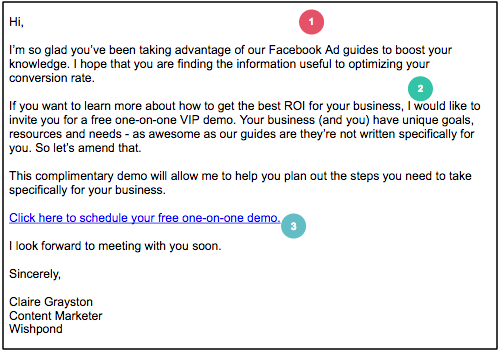
1 – Introduction – Start this email in a more personalized way. Tell leads you’re happy they’ve been reading your content and following along. This seems more welcoming and humanized and shows that you pay attention to every one of your leads.
2 – Invitation/Ask – Include a few sentences inviting them to come in for an appointment or to setup a meeting. Why should they come? What’s the benefit to them? Briefly explain how you can help them succeed.
3 – Call-to-action link – Include your call-to-action at the bottom so that leads can directly signup from your email. Make sure to choose words that flow with the rest of the email, but also reinforce your offer (a free appointment) again.
A drip campaign allows you to gradually build your relationship with new leads. Lastly you can grow the relationship with a sales email, turning that new lead into a prospective customer for your business.
Conclusion
A scorecard review is just one more lead generation strategy to add to your marketing efforts.
It’s time that you gave potential leads something fresh and exciting. Give it a try and you’ll have new leads nurtured into customers in no time.
– Written by Claire Grayston
Claire is a digital content marketer at Wishpond. When not racking her brain for new content, you’ll find her hiking or snowboarding the local mountains or cozied up in bed watching a sappy rom-com..
